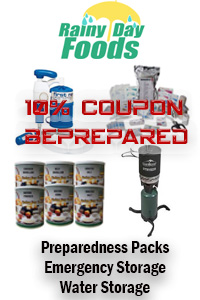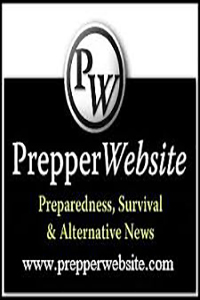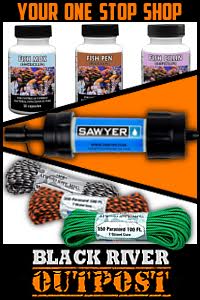Unfortunately the money tree in my back yard stopped growing one hundred dollar bills and online vendors won’t accept leaves as currency. This is mind if often becomes necessary to identify low cost preps or projects which one can undertake, or actions which can be carried out to increase overall preparedness levels. This short list is one I came up with in a few minutes but I’m sure there are many more items which could be added.
1- The Internet: At least for now information online is available and (for the most part) free. There are lots of great preparedness websites out there, some with links to GB’s of data. I also recommend watching YouTube vids for some great instructional how to for projects in the garden or around the home. Cost equates to whatever your data plan is on your phone or whatever your ISP charges at home.
2- Gallon jugs of water: At around 90 cents per jug $20 will go a long way in keeping a (transportable) water supply on hand for short term disasters. There are some considerations to be had in that these have a short shelf life and need to be stored in a cool / dark place and not directly on concrete. Yet we all know just how valuable water is in any survival situation and if for whatever reason the tap runs dry at least you’ll have 5-7 days of potable water on hand.
3- Tin can alcohol stove: Got an old soda can or soup can laying around? You can make an alcohol stove out of it and it makes a fun project when the weather is bad. Check out this video on YouTube or search for other examples as there are many to choose from.
4- Fitness: That’s right, the inside of your house (living room floor) or the street a few yards outside of your front door are calling. While workout facilities are great there are plenty of exercises that can be done in the home, out on the trail or even at your local high school stadium. The only cost here is some sweat and muscle fatigue.
5- Dry Fire: Take your pistol, make sure it’s CLEAR, and practice dry firing or reloading while at home. This literally only costs time and can help to improve techniques when you head out for your next range trip. There is some debate as to whether or not you should dry fire pistols, I do it with my Glock and 1911 consistently and haven’t had any issues.
6- Planning: Plan to shelter in place during a short term disaster but have a bugout location picked out just in case T-SHTF? Do you have primary, alternate, tertiary routes selected? How about studying street and terrain maps of YOUR area as well as the previously mentioned routes. Checkpoints and danger areas identified, bridge crossings, choke points, fuel stops, rest stops, resupply points and areas with limited communication coverage (cell towers). The list goes on and on but in order to be prepared there has to be significant effort put into planning. Cost? Time.
7- Rehearsals / Recon: Having a plan is great but if it’s sitting in a dusty binder on the shelf what good will it do your family? If you have planned for 3 routes in a bugout, have you actually driven those routes and seen the terrain for yourself? How about a simple bugout rehearsal where everyone grabs their assigned equipment, piles into the minivan and heads out. It’s during these rehearsals when you start to figure out what could be done better, or not done at all to improve upon the execution phase of your plan. Cost? Gas money and probably an annoyed spouse.
8- Pocket Chainsaw: Less than $15, I made one a month or so ago. Check out the post for instructions on how to get it done.
There you have it, a small but powerful list. What are some suggestions you have? List them in the comment section below.









5 comments
Skip to comment form
Basically, prepping is just like any other business or production line.
There are three ways to do things: fast, cheap or well. Pick any two.
So really, the point I’m trying to make is you have to know how to use your head and decide where you can afford to be slower, more expensive or where you can cut corners.
This is where everyone is different and one’s own priorities have to come into play.
Have to agree with you CanadianVet. Fast and cheap typically get many in hurry in the prepping world and especially those that might have just started prepping. While preparing for the worst, everyone should remember that “Rome was not built in a day” and your preps are NEVER going to be fully complete. Make a plan, follow that plan, and do not rush things (unless of course TEOTWAWKI happens to be in sight). Also, do not skimp or cut corners, if you cannot afford quality right now, then put that purchase off or find another area requiring what you need at a price you can afford.
Don’t have a tent? Well, search on the internet for field expedient shelters until you can afford a quality tent – buying the $39.95 tent today is more than likely $39.95 thrown out the window. Need more water storage, rinse and reuse 1-gallon jugs that water or other non-spoiling drinking liquid came in and store them under the bed, rotating them to the fridge when space is available.
Also, save the “gadgets” for when your preps are well established and make certain that they are quality “gadgets” that actually serve a purpose or multiple purposes.
Prepping is a long road and no one is going to finish.
Seeds! You forgot seeds … of course I am little more biased towards seeds than most, but they are a very cost affective item to add to your storage.
Author
Mike
Great addition! Seeds are indeed cheap, but the knowledge required to grow them does not come overnight. I’m still in the learning phase.
I am a firm beleiver in doing more with less. My mind set, in regards to this, is that any piece of equipment or gadget can be broken, lost or stolen, effectively rendering it useless. I am always looking for new uses and applications for the equipemnt I have, and new acquisitions are often bought with more than one function in mind.
Being short of cash does not neccessarily mean you cannot continue to expand or improve your gear. Bartering something you have and have realized isn’t critical to your equipment list for something else is a good way to keep making positive progress on your preps.
I also enjoy going camping. It is a good way to field test your prep equipment and have a good time doing it. You can discreetly test your fire building skills, camp cooking and just about anny other type of outdoor skill you might need to develop. This is also a good way to teach your kids in a fun environment. Also, in the event of needing it, you don’t want to find out your tent has a hole in it or is missing stakes. You might also realize that it needs waterproofing. I did, once!
If you really want to get realistic, go camping in incliment weather. In the event of a bugout, you can rest assured that Mr. Murphy will be riding shotgun. Finding effective shelter and setting a camp in cold and/or wet weather is not nearly so easy as doingit when it is sunny and 80.